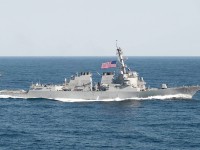
Hu Bo, Director, the South China Sea Strategic Situation Probing Initiative
Nov 12, 2015
US naval actions in the South China Sea are about hegemony and power politics, a prevailing pursuit in the world in the 19th century, under the cloak of a 21st century pretense to safeguard freedom of navigation and international justice. The reality is: The US wants to check any expansion of Chinese power in the South China Sea.

Wang Yusheng, Executive Director, China Foundation for Int'l Studies
Nov 11, 2015
If Washington embraces cooperation instead of pursuing rivalry, all partners can harvest good results, and the US can still be a powerful partner. Why not do so?
Nov 07, 2015
Speaking at the National University of Singapore on Saturday, Chinese President Xi Jinping said that there will never be a problem with freedom of maritime navigation or overland flights in the South China Sea

Zhang Tuosheng, Principal Researcher at Grandview Institution, and Academic Committee Member of Center for International Security and Strategy at Tsinghua University
Nov 05, 2015
Inserting itself in the South China Sea disputes and sending a warship to the waters close to China’s islands and reefs, the U.S. risks escalating the trend of militarization in the region. While the two countries need “quiet diplomacy” to resolve differences, further escalation in U.S. military actions will certainly alienate the general public of China and cause a tougher military response, significantly amplifying the risk of a conflict between the two countries.
Ma Shikun, Senior Journalist, the People’s Daily
Nov 04, 2015
US actions in the South China Sea are an overreaction to China’s legitimate and civil-oriented reef-building there, and even its allies are less than enthusiastic. The age of hegemonism is consigned to the past, and any country that moves in reckless disregard of that will face the consequences at its own peril.

Ted Galen Carpenter, Senior Fellow, Randolph Bourne Institute
Nov 04, 2015
On October 27, the U.S. Navy sent the guided-missile destroyer USS Lassen on a “freedom of navigation” patrol within 12-miles of a man-made islands.in the Spratly chain. Carpenter argues that there are less confrontational ways to pursue that objective without the kind of “in your face” challenge.
Nov 03, 2015
The head of U.S. Pacific Command defended Washington’s position on the South China Sea on Tuesday even as he called for stronger military-to-military exchanges with Beijing, amid signs that both sides are trying to tamp down tensions over Beijing’s territorial claims.
Peter Coy, Bloomberg Business Week Economics Editor
Oct 30, 2015
On Oct. 27 the simmering waters of the South China Sea came to a slow boil. A U.S. Navy destroyer, the USS Lassen, conducted a freedom-of-navigation cruise within 12 nautical miles of a Chinese-built artificial island in the Spratly archipelago. The Chinese government vowed to “firmly react to this deliberate provocation.” Bloomberg Business Week economics editor Peter Coy argues that conflicting claims over the sea don’t have to degenerate into open hostility.
Shen Dingli, Professor, Institute of International Studies, Fudan University
Oct 29, 2015
The US has started a new series of games with China by sending its guided missile destroyer USS Lassen within 12 nautical miles of China's isles in the South China Sea.